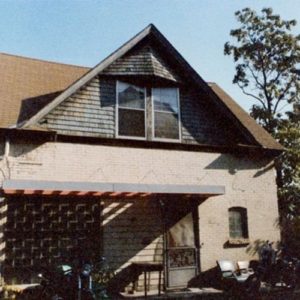This is a good example of what my old pal idb (nee Ward Harper) referred to as my “new primitive” style of creating music for the guitar. I was borrowing my old friend Sean’s room for part of a summer, in a carriage house near the Institute Of Arts in Mpls, and this is one of the things that happened there.
This piece stands as a testimony to what a fellow can do with an empty house, a cassette deck, a Radio Shack potentiometer mixing unit, and a bunch of musical instruments. Not a band, but a snapshot of a moment in time. Technically—if that’s a consideration—it’s pretty rough, but it was definitely inspired, if only by the fact that I had the house to myself one day.
The rhythm guitar track was recorded in a single take, for exactly the length of one side of a 90-minute cassette. The most notable thing about this session was that it was perhaps the hottest day of summer, but I kept the windows closed in order to protect the neighbors, so the floor was quite literally a puddle when I was done. No sooner was that finished, it seemed like a good time to add another guitar part. Tape deck #1 went through the mixer, accompanied by a live guitar. Stretching my limited capacity for playing lead guitar to the limits of… well, my abilities, I guess, the second track also went down in one take. If memory serves, a string broke, somewhere near the end.
I really do wish I had kept at least a copy of that resultant cassette. I played it enough back then, that’s for sure. Alas, as I was prone to doing in those days, I eventually re-used the tape for something else, after additional parts had been added as part of the continuing process. In those days, I tended to behave like something of a Dadaist, when it came to preserving my own work. The only problem with that in this case, is that I’ve never been satisfied with my original mix of the two initial guitar tracks, but it is what it is.
After listening to it several times, I imagined what it might sound like with drums. Never mind that I never could coordinate my limbs behind a kit. I knew where I could get my hands on a set of drums for an afternoon, and so down to the carriage house basement I went. If memory serves, I had to play the drum track twice, due to the levels being uneven the first time. As a non-drummer, playing a 45-minute non-stop drum improvisation twice in a row was physical torture, but it was also very gratifying, in a cathartic sort of way.
The piece sat around for a while after that, and I wasn’t sure what to do with it. I was a little frustrated with myself for not having kept the original tape, but I thought there was still something there worth working with. At some point, I asked a couple of friends if they would be interested in adding a few layers to the tape. We had played together previously, but never at the same time, and never with any real plan, other than to play. In that respect, this situation was no different – none of us were familiar enough with the tape, as to have any preconceived ideas as to what our parts would be. I knew that once we were finished, it would be done, and so it was.
Some twenty years later, I listened to it again, and decided that the piece needed editing. It seemed to have five natural sections, based on transitions I thought I was hearing. Breaking each of those sections down one step further provided the seven themes presented here. Who knows – perhaps those miniature themes are what I was hearing all along.
excerpts from “benevolent dreams”
[Sorry – this audio recording was hosted on soundcloud, but that account is now closed.
I’ll figure out a different way to host it soon!]
technical errata:
original indexed tracks – one continuous piece split into five parts
(total running time: 41:51)
001 (11:56)
002 (6:48)
003 (8:04)
004 (9:45)
005 (5:16)
the tweaked version – segments extracted from the above sections
(total running time: 19:32)
001 [001-1] occurring theme (3:04)
002 [001-2] no cause for alarm (2:32)
003 [002] dervish wind (1:53)
004 [003] slapstick treaty (3:54)
005 [004-1] merrily cavort (3:19)
006 [004-2] whims of change (3:07)
007 [005] druid scene (1:43)
1st pass: live rhythm guitar > cassette deck
2nd pass: live solo guitar added to recorded rhythm guitar track > second cassette deck
3rd pass: live drum kit added to recorded rhythm guitar/solo guitar tracks
4th pass: live bass guitar, distorted guitar (courtesy of Sean Smuda), flute + percussion (courtesy of Bebhinn Smuda); added to recorded drum/rhythm guitar/solo guitar tracks
recorded at the carriage house with two cassette decks and a 4-potentiometer pass-through mixing device; circa 1987 [?]
All tracks recorded live and in a single take (except for the drum kit, which had to be recorded twice, due to uneven volume levels), direct to 2-channel cassette deck.
azimuth-optimized analog-digital transfer from cassette; .mpeg conversion: December 2008
all tracks: © J.Free; 1987

